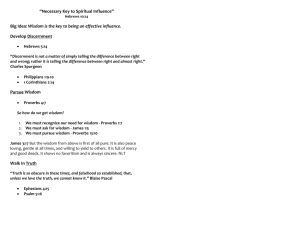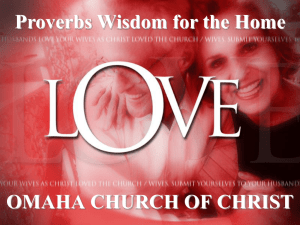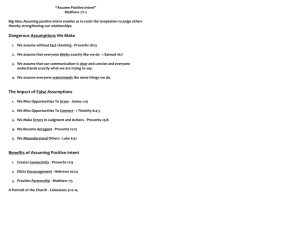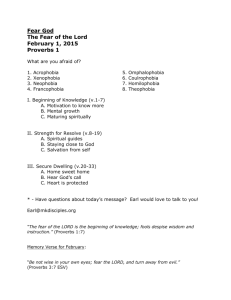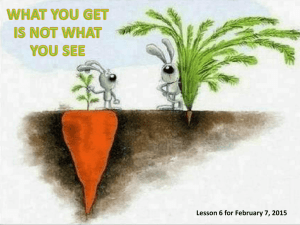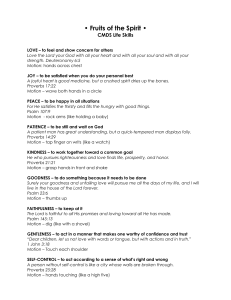Day 2 Post
advertisement
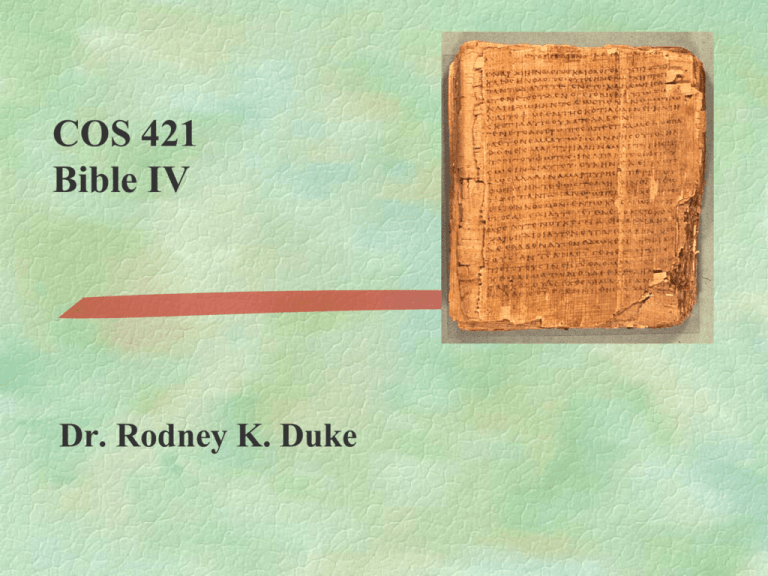
COS 421 Bible IV Dr. Rodney K. Duke DAY 2 Assign: (see handout) 1) (Daily) Write in a journal entry 2) #5 Analyze Pro 26:22 and 17:22 3) #6 Form psalm pairs 4) #7 Learn about the Israelite priesthood and *cultic symbol system (sent as Duke_Priests.pdf) 5) Review for discussion: Section B. #5 [*“cult” = tangible expression/practice of religious beliefs] Day Objectives: (Finish Wisdom Lit and Intro Hymnic Lit.) 1) Describe the nature of wisdom lit. and how proverbs apply. 2) Describe the Israelite world-view and how it relates to wisdom. 3) Describe how psalms functioned in the Temple setting. 4) Define “cult” and identify Israelite cultic elements. JOURNAL THOUGHTS & OBSERVATIONS Homework problems? Process of Communication: Three Images Addresser Rhetorical intent Rhetorical strategy/“rules” “Picture” (world of) Medium focus on text itself “Mirror” (world in front) Reflects what reader brings Literary features Form Content Reading strategy/ “rules” Rhetorical impact Addressee “Window” (world behind) Embeds some authorial intention Referent Class Discussion on Wisdom Literature A. 3. Obj.: Become acquainted with one form of biblical wisdom literature. Read: Ecclesiastes. a) (T) A key motif in this book is, “under the sun.” What does that mean? (Remember that the Israelites conveyed God’s sovereignty by speaking about Him as enthroned above the heavens/the sun.) b) (W) Write out a brief response to this book. (Develop any one observation, question, reaction, or comment you have about this text. Do not retell the content.) Class Discussion on Wisdom Literature A. 4. a) b) c) d) e) Obj.: Become acquainted with a second form of biblical wisdom literature: Job (T) Job is often characterized as “patient.” Do you think he was patient? (T) People, particularly in the church, give all sorts of “pat answers” about the reason for suffering and how to handle suffering. What are some of those “pat answers”? How are they like the some of the responses of Job’s friends? (W) You, as the reader, learn in 1:1-12 why Job is suffering. He questions his sufferings and challenges God. How would you describe God’s speeches and Job’s response(ch 38-42)? (Are Job’s questions answered? Is he satisfied?) (W) What do you learn about God and suffering from Job? (T) What do learn about “the Satan” (= “the adversary”)? (HW #1) “Subtypes” • Pro 1:20-33 Extended Wisdom Poems • Pro 10:1-5 mashalim, “proverbs” • Pro 22:17-23 Sayings of the Wise • Pro 30:15-16, 18-19, 21-23 Numerical Sayings (HW #2) Proverbs 20:1-15 (1 of 3) 1 a: two images (metaphors & personification) b: complements by giving a conclusion/teaching explicitly 2 a: simile (could stand alone) b: explains simile by drawing out consequence of the relation 3 b ("but") stands in contrast to 'a' note ellipsis: [wise person] honor avoid strife fool [shame] quick to quarrel 4 a: cause b: effect/result ("so") 5 a: metaphor (could stand alone) b: qualifies ("but") 'a' (HW # 2) Proverbs 20:1-15 (2 of 3) 6 a: makes a claim (could stand alone) b: qualifies/contradicts ("but") 7 a: makes a statement of principle/definition b: gives a result, making 'a' a cause 8 a: begins temporal sequence "when” b: gives following event (then) 9 a: raises a theological question using imagery b: continues/clarifies 'a' further, more explicit note 'ballast': "Who can say" implied in line b 10 a: object of verb given first (emphasis) b: gives subject and verb = evaluation of 'a' (HW #2) Proverbs 20:1-15 (3 of 3) 11 b: builds on 'a,' expands on the last element ("stair step" pattern) 12 a: object of verb given first (emphasis) b: gives subject and verb = evaluation of 'a' 13 a: states point in negative form b: “synonymous” to 'a' by stating point in positive form 14 a: presents an illustration from life (market place) b: in sequence to 'a,' serves as commentary on market tactics 15 b: stands in contrast to 'a' a: seems to be an exaggeration until contrasted to 'b’ (serves as "hook") (HW #3) Like one who seizes a dog by the ears, is a passer-by who meddles in a quarrel not his own. Proverbs 26:17 What is similar? (HW #3) Proverbs 13:14 The teaching of the wise is a fountain of life, turning a person from the snares of death. Relationship between lines: cause and effect? 1st line: uses metaphor 2nd line: graphic image of hunting (HW #3) Proverbs 25:27 (comparison implied) Not good to eat too much honey What is similar? Not honorable to seek honor result result (Images evoked) Get sick! Disgusting Discuss Wisdom Literature A.5. Obj.: Uncover some aspects of the historical context of wisdom literature (composer, transmitter, collector). a) (N) List some non-biblical proverbs. b) (W) Reflect on: settings of the origins? How passed on? Why collected? c) Speculate on how the biblical proverbs originated. Verses to guide your thinking: Read: Group 1: 24:30-34; 25:2; 30:24-28. Read: Group 2: 10:2,16; 11:4; 12:28; 14:31; 16:2,9; 19:21. (N) What differences do you notice between these two groups regarding their sources/origins? Proverbs 24:30-34 (NIV) 30 I went past the field of the sluggard, past the vineyard of the man who lacks judgment; 31 thorns had come up everywhere, the ground was covered with weeds, and the stone wall was in ruins. 32 I applied my heart to what I observed and learned a lesson from what I saw: 33 A little sleep, a little slumber, a little folding of the hands to rest-34 and poverty will come on you like a bandit and scarcity like an armed man. #A. 5 cont. Read: Pro 1:1; 10:1; 22:17; 24:23; 25:1; 30:1; 31:1. (N) What is the function these verses have in common? (W) What do you learn about the preservation and transmission of proverbs in these verses? What do you learn about the history of the composition of the Book of Proverbs? Results of A 5. Main points: a) Our proverbs: often based on experience, observation. b) Biblical: based on 1) experience, and 2) faith perspective. c) Collected by kings (sages were connected with court). Titles do not really show authorship. Solomon is not the author of all of the proverbs, but the archetypal wise person. d) Proverbs is a collection of collections. Jar used to store written documents Excursus: BIBLICAL INSPIRATION* Nature of Inspiration: Does the literature in the Bible carry out God’s communicative purposes? NOTE: Maybe not our 21st century expectations of being able to determine the authorship, date of writing, unity of writing, etc.) (For modern people “author” = “authority”.) Question: Could God work through the community of faith over several generations to preserve, shape, and edit the biblical text AND it still be inspired for God’s communicative purposes? *See slides, Reliability and Modern Assumptions.pptx Differences between Oral and Writing Cultures Oral Culture •Authority based on spoken (memorized) words of teacher/tradent •Based on communal knowledge •Words are dynamic, visual and dramatic •Performance oriented •Fluidity to respond to audience and situation •Communal interpretations Writing Culture •Text as authority/orthodox •Text as unchanging artifact •Teaching is static •Rule oriented •Individual interpretations #A. 6. Discover How Proverbial Wisdom is to be Applied Prov. 26:4 Do not answer a fool according to his folly, or you will be like him yourself. Prov. 26:5 Answer a fool according to his folly, or he will be wise in his own eyes. Which proverb should the wise person follow?* Most proverbs (except theological ones) are generally applicable (across time and place) but are not absolutely applicable in every time and place. *The wise person knows what proverb applies in a given situation. A. 7. Obj.: Characterize the world-view behind Proverbs. Read: Pro 1:18-19; 2:7-8; 10:27; 12:21; 13:21. a) (T) What kind of assumptions or perspective about how the world operates seems to lie behind these passages? Now read: Pro 11:16b; 13:23; 15:16; 16:8. a) (T) How might these texts cause you to revise your first impression? b) (W) Because the books of Job and Ecclesiastes reflect on the presence of evil, suffering, and disorder in the world; they have often been viewed as containing a "higher" order of wisdom than Proverbs. Proverbs is often characterized as simplistic, traditional wisdom, in which the good and the bad get their just rewards in a mechanistic way. Discuss whether or not this characterization of Proverbs correct. c) (T) How does your worldview compare or contrast to that of Proverbs? A. 7 How Does the World of Proverbial Wisdom Work? What kind of world do the sages of Proverbs envision? Does it operate simplistically and mechanically? Is the world complex? Main point: Most books on Proverbs say that this form of wisdom is very simple-minded. It thought the world operated mechanistically. This is a false impression created by the literary nature of proverbs: their use of stereotypes and stark contrast to make a principle clear. There is evidence within Proverbs that the world does not work so smoothly: It is better to be poor and righteous, than wealthy and wicked, etc. A. 8. Key to Israelite Wisdom 7. Obj.: Identify the Israelite "key" to living wisely. (If you were an ancient Israelite, what would you need first to "do" to become wise?) Read: Pro 1:7a; 9:10-12; 15:33; Ecclesiastes 12:13-14; Job 28:28; Psalm 111:10. a) (W) How would you define/explain the Israelite key to wisdom? (For more insight into the above concept, you might want to check: Deuteronomy 6:24; Psalm 130:4; Isaiah 11:2-3; Acts 10:35; Philippians 2:12; Hebrews 12:28-29.) A. 8. Key to Israelite Wisdom “FEAR OF YAHWEH” 2 Major Components: 1) Emotional: awe 2) Action: obedience = Proper relationship (HW #4) Genesis 1 Read Gen 1:1-2:3. Describe the literary form of this section. (What type/style of writing is this? How is it structured?) Describe your impression of the created world after reading this text. What does "good" mean here? Photograph from Hubble Telescope Genesis 1 “Spirit of God” Darkness Watery Deep Formless Earth Days of Creation Day 1 -------------------darkness/light separates Day 2 -----------------------waters separates Day 3 ---------------------- “earth” separates Day 7 ----- rests Day 4 fills Day 5 fills Day 6 fills One Egyptian Cosmology Sky-goddess Nut, arched as the heavens, supported by the air-god Shu; at his feet the earth-god Geb. Biblical Cosmology Form and Function of Genesis 1: Observations/Conclusions 1. (General) Hebrew ‘historical narrative’ combines: #historiography (“Something like this happened…”), #“science” (Rational explanation of cosmology from a phenomenological perspective (common observation), theology (The character and involvement of God), and aesthetics (Well composed “poetically”). #Early biblical interpreters: God “accommodated” Himself by using common language/concepts to communicate. 2. (Specific) *God has created an orderly world (nature, moral, etc.). Note how both the form and content of Genesis 1 work together to create the impact the God has created an ORDERLY world. *This teaching is the main theological presupposition of Israelite wisdom. Duke: World Picture vs. World View World Pictures: • Phenomenological perspectives based on current “scientia” (knowledge) • Changes with cultures • Changes through time as knowledge grows World Views: • Address the basic philosophical questions of life (origins, dimensions of reality, purpose, values, etc.) • May be expressed through different world pictures • May abide through time and cultural changes ISRAELITE WISDOM LITERATURE (1 of 2) Definition of Hebrew term hochmah (wisdom): skillful living I. Premise: Yahweh has created an orderly world. (Gen 1) A. Ultimate source of wisdom: Yahweh; therefore, "fear the LORD" (awe and obedience, a relational expression) B. Avenues to wisdom: 1. Reflection on experience, the observations of order (See Proverbs 24:30-34) 2. Reflection on the nature of God (revelation) ISRAELITE WISDOM LITERATURE (2 of 2) II. The fruit of wisdom is life. (Prov 3:18; 8:35; 14:27) A. 'Life' and 'death' are not used in an absolute sense. [Proverbs often appear to be simplistic, due to use of opposites, but are not. ] B. 'Life' and 'death' are dynamic processes. A person is on the path of 'life' or the path of 'death'. C. 'Life' generally emphasizes "abundant life" rather than "eternal life;" however, D. Wisdom presses the bounds of Israelite theology towards a concept of an afterlife. (Pro 12:28; Psalm 73) Proverbs 12:28 In the path of righteousness is life, But the way of error leads to death. (RSV) In the path of righteousness is life, in walking its path there is no death. (NRSV) Value of Wisdom Literature for the Church Today A. 9. Obj.: Reflect on the value of the wisdom literature for Christian faith and practice. (W) Based on the above assignments regarding wisdom literature, explain, as if speaking to a member of your congregation, why it is valuable for Christians to read and study the Old Testament wisdom. Introduction to Hymnic Lit. If a “pocket” New Testament includes just one book from the Old Testament, which book is usually included? Why this book? How would you describe the “book” of Psalms? (B.1.d) What has Psalms meant to you? / What role should it have in the life of the Church? ADDRESSING BACKGROUNDED ASSUMPTIONS What do we mean by “reliable”? What is the personal response to that which is reliable? IF SCRIPTURE IS “RELIABLE,” WHAT IS IT RELIABLE FOR? 2 TIMOTHY 3:14-17 14 But as for you, continue in what you have learned and have become convinced of, because you know those from whom you learned it, 15 and how from infancy you have known the holy Scriptures, which are able [Duke: “empowering”] to make you wise for salvation through faith in Christ Jesus. 16 All Scripture is God-breathed [Duke: or “God breathing”] and is useful for teaching, rebuking, correcting and training in righteousness, 17 so that the person of God may be thoroughly equipped for every good work. Red = purpose statements POSSIBLE “MODERN” ASSUMPTION •To be reliable, it (e.g. Book of Isaiah) must be written by one person from the first word to the last! Why? The evidence is that much of the Bible is communal literature that was passed down in both oral and written forms and was shaped by the community of faith for generations. POSSIBLE “MODERN” ASSUMPTION •We will find systematic, propositional truths about God! (E.g. God is omnipotent, omnibenevolent, omnipresent, etc.) Why? Psalmists, prophets, and others move from relational experiences with God to general conclusions about nature of God (top down), not from placing abstract definitions onto God (bottom up). Poles of Communication Emotive Addresser | Means------------------------|---------------------Referent Poetic Referential | Addressee Conative (persuasive) “Modern” readers tend to want to limit truth and meaning to scientific referential statements. What about: “If your eye causes you to sin, pluck it out?” Is that referential? Does it have meaning? What poles are emphasized? What is its function? POSSIBLE “MODERN” ASSUMPTION •Biblical teaching will be logically consistent! Yes, but, consistent to the purposes of the Scripture! Proverbs 26:4,5: 4) Do not answer a fool according to his folly, or you will be like him yourself. 5) Answer a fool according to his folly, or he will be wise in his own eyes. POSSIBLE “MODERN” ASSUMPTION •All biblical narratives/stories must be historically accurate in all aspects to be true! Why? Even our culture does not make an absolute separation between history and fiction. We have a range of literature with “blends”: fables, parables, legends, tall tales, dramatic enactments, historical fiction, fictional history.
